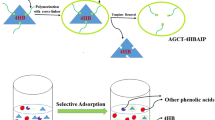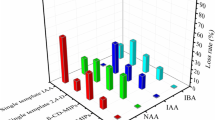Abstract
Fruits and vegetable waste (FVW) have been reported to have micronutrient and bioactive compound like polyphenol albeit in very small quantity (μg g−1). The challenge of selective separation and recovery of one of the polyphenols from dilute solution is addressed in the present work using molecular imprinting technique, which uses molecularly imprinted polymers (MIPs). This study focuses on the extraction of a high value bioactive compound [P-Hydroxybenzoic acid (PHBA)] which is present in FVW. Chitosan-based PHBA imprinted polymer was synthesized using PHBA as template and TEOS as cross-linker to achieve the above goal. MIP was characterized using SEM, EDAX and FTIR. Batch adsorption studies were conducted to optimize the adsorbent dose, initial concentration, and contact time. Two-parameter isotherm models namely Langmuir, Freundlich, Temkin and Dubinin–Radushkevich and three-parameter isotherm model Sips was used to analyze the experimental data. The equilibrium data fitted best into Langmuir isotherms model with capacity of 74.56 mg g −1 and followed pseudo-second-order kinetic model. The reusability confirmed that MIP retained its adsorption capacity up to 6 cycles.










Similar content being viewed by others
References
G.G. Duthie, S.J. Duthie, J.A.M. Kyle, Nutr. Res. Rev. 13, 79 (2000)
P. Mattila, J. Hellström, R. Törrönen, J. Agric. Food Chem. 54, 7193 (2006)
S. Pardeshi, A. Kumar, R. Dhodapkar, Mater. Sci. Forum. 675, 515 (2011)
P. Mattila, J. Hellström, J. Food Compos. Anal. 20, 152 (2007)
Y. Zuo, C. Wang, J. Zhan, J. Agric. Food Chem. 50, 3789 (2002)
Q.W. Zhang, L.G. Lin, W.C. Ye, Chinese Med. (United Kingdom) 13, 1 (2018)
O.P. Sharma, T.K. Bhat, B. Singh, J. Chromatogr. A 822, 167 (1998)
S. Mandal, B.D. Kulkarni, Int. J. Chem. Eng. 1–11 (2011)
D. Rahangdale, A. Kumar, .J. Environ. Chem. Eng. 6, 1828 (2018)
W.S.W. Ngah, L.C. Teong, M.A.K.M. Hanafiah, Carbohydr. Polym. 83, 1446 (2011)
J.H. Chen, Q.L. Liu, X.H. Zhang, Q.G. Zhang, J. Memb. Sci. 292, 125 (2007)
P.O. Osifo, A. Webster, H. van der Merwe, H.W.J.P. Neomagus, M.A. van der Gun, D.M. Grant, Bioresour. Technol. 99, 7377 (2008)
G.J. Copello, M.E. Villanueva, J.A. González, S. López Egües, L.E. Diaz, J. Appl. Polym. Sci. 131, 1 (2014)
E.E.M.F. Lemos, P.S.O. Patrício, M.M. Pereira, Quim. Nova 39, 462 (2016)
F. Al-Sagheer, S. Muslim, J. Nanomater. 1–7 (2010)
D. Rahangdale, A. Kumar, Carbohydr. Polym. 202, 334 (2018)
M.G. Kamble, S.K. Deokar, S.P. Tajane, S.A. Mandavgane, Chem. Technol. 27, 35 (2020)
S.K. Deokar, G.S. Bajad, P. Bhonde, R.P. Vijayakumar, S.A. Mandavgane, J. Polym. Environ. 25, 165 (2017)
N. Ayawei, A.N. Ebelegi, D. Wankasi, J. Chem. 1–11 (2017)
Acknowledgments
Author are thankful to ACES-2020 for inviting the paper for Special Issue,
Funding
Authors also thank Department of Science and Technology (DST) for financial support (Project Grant DST/ TDT/ TDP-02/2017) for directing the work.
Author information
Authors and Affiliations
Corresponding author
Additional information
Publisher's Note
Springer Nature remains neutral with regard to jurisdictional claims in published maps and institutional affiliations.
Rights and permissions
About this article
Cite this article
Dadhe, P., Mandavgane, S.A. & Kumar, A. Separation and Recovery of 4-Hydroxybenzoic Acid Using Molecular Imprinting Technique from Dilute Solution. J. Inst. Eng. India Ser. E 103, 135–143 (2022). https://doi.org/10.1007/s40034-020-00198-7
Received:
Accepted:
Published:
Issue Date:
DOI: https://doi.org/10.1007/s40034-020-00198-7




